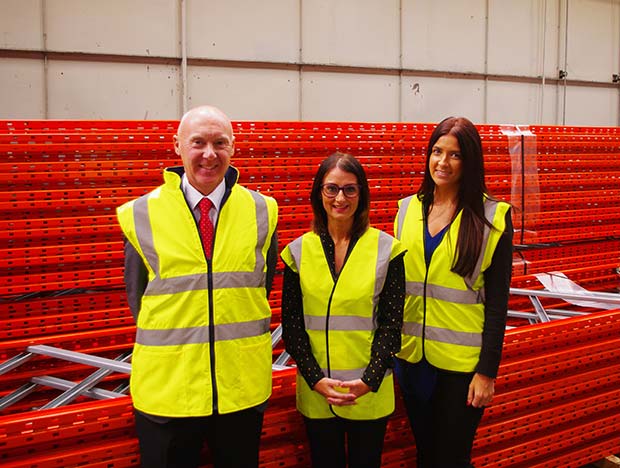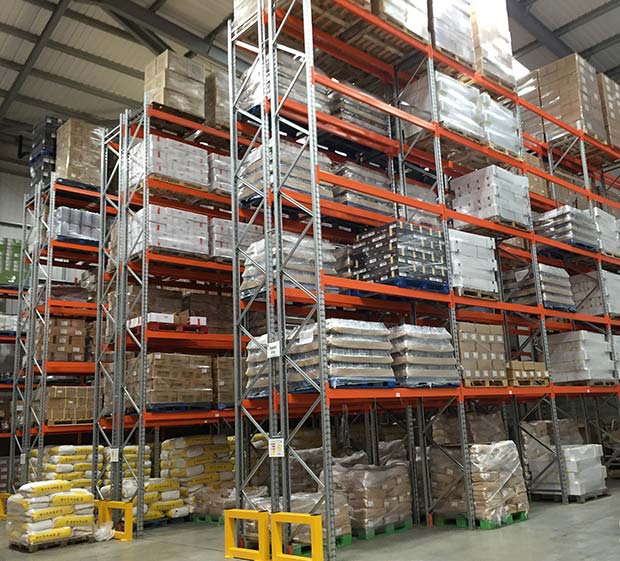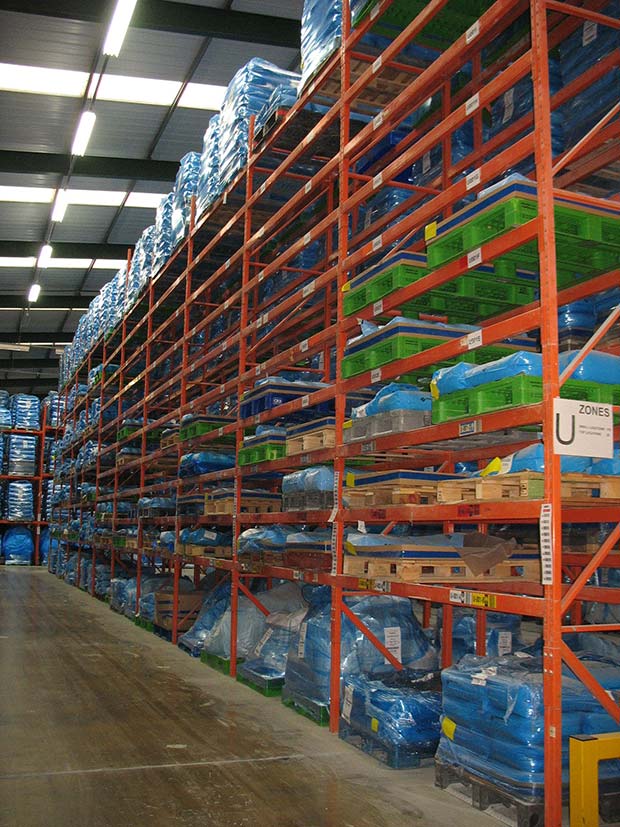Stakapal has maintained a unique position in the UK’s storage industry for over 45 years as the only British manufacturer producing all three types of racking, cantilever, pallet and shop racking. Stakapal’s current operations include the Redirack business, which they bought from the administrators in 2014.

Stakapal have been active SEMA members for a quarter century and Nick Betteley, Stakapal’s present owner and Technical Director, is a former President of the association. With the SEMA 2018 Safety Conference approaching, Nick Betteley spoke to Warehouse & Logistics News.
Warehouse & Logistics News – First of all, Nick, for readers who might not know, how did the Stakapal story start?
My father, Colin Betteley and his colleague Albert Tonks formed Stakapal in 1967. They began manufacturing steel stillages and became one of the three largest suppliers in the sector by the time of the early eighties recession. The severity of the downturn forced them to seek other products and markets and they began making cantilever and pallet racking in 1983. A completely new pallet racking system, which is still in production, the SR2000 series was launched in 1992, and Stakapal became full SEMA members that same year.
WLN – You’re a former SEMA President. Are you still personally involved with the Association?
Yes, I sit on the SEMA council, the technical committee and the SARI committee as well as being a SEMA Approved Racking Inspector (SARI.)
WLN – You have a broad racking portfolio. What are you best known for?
We’re probably best known for our market leading cantilever racking, although we’ve always had a near 50:50 manufacturing split between that and pallet racking. The very different production methods involved mean we’re unique in making both types on one site. We are probably best known for multi-project work.
WLN – What happened to Redirack?
The previous owners bought the business from the Dexion group’s receivers in 2003. There was a level of debt involved to finance the initial purchase and it proved difficult to make enough profit in a highly competitive market to pay down debt while also investing in the new plant and equipment. Welded frames are much more expensive to make than bolted frames and the company’s commitment to supplying only welded frames, coupled with costly production using ageing plant and equipment eventually led to administration in January 2014.
 WLN – What motivated you to purchase Redirack?
WLN – What motivated you to purchase Redirack?
Redirack has had a leading presence in the UK pallet racking market since the 1960’s and is a well known, highly regarded brand. As a welded system it has long been renowned for its robustness in operation, offering high levels of user safety. Indeed Stakapal supplied Redirack Pallet Racking in the seventies to customers wanting integrated rack and stillage solutions.
I was on good terms with the joint Redirack owners Phil Culling and Jack Holden, having attended SEMA Council meetings alongside them for many years. I appreciated their passion for the company and the brand and felt motivated to preserve and enhance that heritage when the opportunity arose. Hence we acquired the Assets and IP rights from the administrators in February 2014 and set about resurrecting the brand.
WLN – What changes have you made to the old Redirack product?
We began work on a new bolted post design almost as soon as we signed the paperwork with the administrators. As we were doing a lot of testing on our Pallet Racking to meet the new SEMA Pallet Racking Design Code alongside the CEN code EN15512, the testing equipment was in place the minute the new profile came off the rolling mill. We had invested in new tooling within weeks of buying the assets and a new bolted Redirack system was rolling off the production line less than four months later at our Norton Canes factory.
The new Redirack system incorporates the key features of the multi-hook beam lugs and is totally interchangeable with most Redirack installations, without compromising the original structural integrity.
WLN – So are welded frames still available?
One of the design criteria for the new system was to enable the posts to be offered as a welded option. That is because welded frames are generally stiffer than bolted frames and there are systems where it is not, based on our computer modelling, prudent to replace welded frames with bolted frames. For example we would rarely replace existing welded Drive-In frames with anything other than a welded frame. In standard and VNA Pallet Racking installations, frames over 8m high and carrying a bay load over 10 tonnes would typically also be only replaced with welded frames.
 WLN – How can I be sure I am getting UK-made replacement Redirack products?
WLN – How can I be sure I am getting UK-made replacement Redirack products?
The most important requirement is for users to ask their supplier where the product is sourced. Customers have the right to know what they are buying and seek guarantees that the system will not be impaired by the work being carried out. It is also important for users to establish that the insurance cover of the repair company covers the whole system and not just the repaired/replaced item in the event of a problem.
In addition, all beams manufactured by Redirack, unless expressly ordered otherwise, are now down welded 75mm, which improves the beam’s performance with regards to deflection. Uniquely a new heavier duty 4 lug connector is now also standard on all beams over 2500 kgs capacity. All new post sections have a return flange on the rear of the post, as with the old Redirack welded posts, so there are no straight side flanges manufactured by ourselves as they tend to be prone to distortional buckling.
WLN – Are Sacrificial legs still available?
If a frame was originally designed and supplied with a Sacrificial leg, then a damaged item can be replaced with our new design Sacrificial leg. We changed the design of the original Redirack Sacrificial leg because we were concerned about the robustness. Typically a frame has a horizontal brace at low level connecting the front and rear uprights, which helps to limit damage. With a Sacrificial leg frame there is no bottom horizontal brace so we introduced an additional diagonal brace to the rear of the leg, bolted to the floor to act in a similar manner to the missing horizontal brace.
WLN – Do you still allow repair of welded bracing?
Bracing repair kits are available to repair bracing damaged to a maximum bend of 30mm, provided there are no tears to any welded joints or damage to either of the uprights. The bottom diagonal brace in a frame fitted with a Sacrificial leg cannot be repaired once damaged beyond SEMA limits and the frame will need to be replaced.
Responsibility for repairs lies with the repairer and on no account should any bracing be repaired if there is damage to any welded joint on the brace or damage to either of the upright posts beyond SEMA Green Risk levels. On no account should any brace be straightened without a repair kit fitted and a damaged brace should not be cut out of the frame.
WLN – How can I be sure new Redirack equipment maintains the structural integrity of my system?
Redirack are full members of SEMA as they are a trading division of Stakapal. As Redirack are manufacturers of original equipment with accreditation through the SEMA QAS scheme end users are assured that replaced and repaired equipment supplied will not impair the original system’s structural integrity. All new Redirack products have been subject to rigorous in-house testing and continuous on-going research is also carried out. For example, we are currently conducting tests to ascertain the reduction in load carrying capacity of post sections damaged to SEMA Amber Risk levels.
WLN – Is it allowable to repair Redirack systems with ‘compatible’ materials?
There is nothing to prevent end users carrying out repairs to Redirack equipment using non-Redirack products. Responsibility for maintaining the equipment lies with the user under the various safety regulations such as the PUWER regulation and the Health and Safety at Work Act. However, should the user alter the system’s structural integrity, the responsibility lies with them. If the repairs are carried out by a third party using non- OEM products then the user should take care in ensuring that the third party’s insurance covers the altered structural integrity of the whole system rather than just the items repaired or replaced.
WLN – How can I purchase new Redirack equipment?
We typically work directly with end users although we also work with a number of distributors previously accredited as Redirack Authorised Partners and now titled ‘Preferred Distributors.’
WLN – What support do you offer clients?
Danielle McDermott and Rachel Barker head up our sales team and are responsible for business development and sales support of the Redirack product, backed by a technical support team of qualified Mechanical Engineers. I personally lead the Redirack team overseeing, in particular, the technical work. All direct installation work is carried out by SEIRS qualified installers.
WLN – Do you inspect Redirack systems?
We carry out rack inspections on all Redirack and Stakapal products. We have three in-house SEMA Approved Rack Inspectors (SARI’s) and special arrangements with a number of other SARI’s.
WLN – And finally, what does the law require in terms of racking inspections?
Legal Compliance requires annual or bi-annual inspection of your racking by a technically competent person i.e. a SEMA Approved Rack Inspector (SARI.) With our extensive knowledge of Storage Equipment, you can be assured of expert advice when it comes to Rack Safety and Inspections.




Comments are closed.